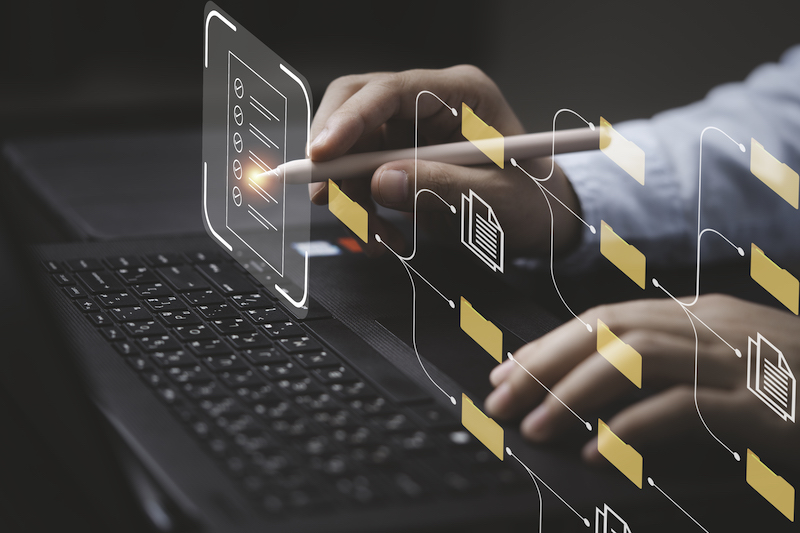What are Secure Email APIs?
Tuesday, October 3rd, 2023APIs are just one tool that organizations can use to streamline operations and automate processes. Healthcare organizations can utilize secure email APIs to save time and streamline their operations. This article explains what secure email APIs are and ways that healthcare organizations can use them while maintaining HIPAA compliance.
What is an API?
First, let’s take a minute to review what an API is. API is an acronym that stands for “Application Programming Interface.” APIs enable companies to open their applications’ data and functionality to external third-party developers, business partners, and internal departments. They leverage each other’s data and functionality through a documented interface. APIs simplify app development by allowing applications to work together.
APIs help business and IT teams collaborate. Let’s look at a simple example to illustrate how they work. If a smartwatch developer wanted to display the weather on the watch face, they could use the Weather Underground API to source current weather data and local forecasts. Application developers do not have to create an entirely new weather database and keep it updated. Instead, the API permits them to use the Weather Underground’s meteorological data in their application.
APIs enable information to flow both ways. The smartwatch can display Weather Underground forecasts, and the API can report data back to the Weather Underground. This functionality enables interoperability and data sharing.
What Are Email APIs?
An email API allows applications to send emails and deliver email data to other systems. Email APIs are often used to send transactional emails from applications like CRMs, EHRs, and other databases. Trigger-based emails are ideal for sending with an email API. In this situation, emails are sent when pre-determined conditions are met. For example, an order confirmation is a transactional, trigger-based email. A person buys a product online, the transaction is processed within the e-commerce application, and an email is sent to the buyer with their transaction details. The email is sent automatically with an email API and pulls data about their purchase from the application into the email message to provide a personalized record of their order details. The API can also return data to the application about the email delivery, including information about who opened and clicked on a link within the message.
When to Use Secure Email APIs?
When transmitting information that may be sensitive, it’s essential to utilize email APIs that offer additional security features. For example, suppose healthcare organizations want to use email APIs to send appointment reminders from their electronic health record system. As a covered entity subject to HIPAA regulations, those emails contain ePHI and must be encrypted to protect that data as required under the HIPAA Security Rule.
Organizations subject to regulatory compliance regulations should ensure they utilize a secure email API service that enables them to encrypt their email messages (in addition to meeting other technical security standards).
What is Required for Email API Security?
Email encryption is essential to help organizations meet compliance requirements and protect data. However, secure email APIs also include additional features to help protect employee accounts and client data. Some key email API security features include:
Authentication
Controlling access to the API is essential to ensure unauthorized users cannot send emails. Email APIs use access tokens to grant specific users access to resources and data and ensure that only authorized users can send emails.
You can also enable DMARC, SPF, and DKIM with email API sending to prevent spoofing and build trust with your users. These protocols help prevent impersonation and improve email deliverability.
Access Controls
Access to the API should be logged and reviewable to make it easy to detect suspicious activity. To meet compliance regulations, you must keep audit logs that track who accessed sensitive data and when.
Benefits of Secure Email APIs
Imagine if it was an employee’s responsibility to create and send every unique appointment reminder email for a practice. It would be completely overwhelming. Besides saving time, some of the main benefits of email APIs include:
-
-
- Easy to use and implement
- Cost savings
- Email deliverability improvements
- Email list management
- Reporting and analytics functionality
- Personalization and customization
- Enterprise-grade security
-
Secure Email APIs Use Cases for Healthcare
Healthcare organizations are under increasing pressure to improve the patient experience. Online shoppers expect to see those order confirmation emails within a few minutes of finalizing their orders. Healthcare consumers using online communication tools expect the same experience from their providers. By expediting and personalizing patient communications, email APIs can help increase patient satisfaction.
Some examples of the types of emails that healthcare providers can send using an email API include:
- Welcome emails
- Appointment reminders
- Patient satisfaction surveys
- Flu shot and vaccine reminders
- Password resets and other transactional emails
It works like this: the developer creates the email templates in advance and the criteria for email sending. The email is automatically sent when the conditions are met. For example, a developer may trigger a welcome email to send when:
1) a new patient is added to the database, and
2) their first appointment date is set.
Email APIs can also pull information from the patient record to personalize the email. The welcome email may include the patient’s name and the date of their first appointment.
Other than updating the patient record, office administrators do not need to take additional actions to send the email. The email API automatically sends customized emails when appropriate, saving time and stress for administrative employees.
Conclusion
Email APIs are an essential part of digital health transformation and interoperability. Healthcare organizations should explore how APIs can improve their workflows and improve efficiency. LuxSci provides HIPAA-compliant and secure email APIs with Secure High Volume Email Sending. Contact us today to learn more.









